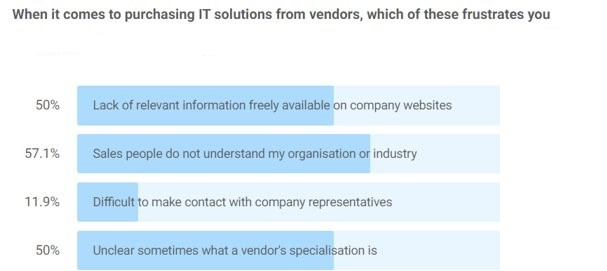As well as increasing awareness and generating demand for services and products, the role of B2B tech marketers is to support their prospects and customers with relevant and timely information as they move along their often-complex buying journeys.
Of course, this is the ideal scenario, and there are various factors that prevent this process from running as smoothly and easily as it should.
According to research conducted at a recent CIO Crowd event, there are a number of frustrations that senior IT professionals feel when it comes to purchasing solutions from vendors.
The Frustrations
The top issue frustrating IT buyers is that sales people do not understand their organisation or industry, with 57 per cent of respondents citing this.
In joint second place (both 50 per cent), were a lack of relevant information freely available on company websites, and a lack of clarity about what a vendor’s specialisation is.
Also mentioned were difficulty in making contact with company representatives (12 per cent) and a lack of quality vendors with good customer service.
While these issues are problematic, there are a number of ways sales and marketing teams can overcome them.
1. Use account-based insights for more relevant and effective follow-up
While responding to follow-up calls and marketing messages can be a hassle that interrupts their day, senior IT decision makers will provide informed consent to receive these if they believe you are going to address a pain point they are experiencing.
Identifying the potential pain points within an organisation or buying team can provide a valuable connection with the prospect and allow your sales team to demonstrate knowledge of their prospects.
Our research found that a sales rep that is familiar with the organisation they are looking to do business with increased the likelihood of a purchase by 71 per cent.
Marketers can help sales teams by providing the right data and insights to ensure follow-up activity is accurate and prioritised in the right way. Account-based views, for example, can help sales and marketing teams understand who within an organisation is engaging with what content or event, and where and when they are doing so.
A lack of insight, on the other hand, can end your efforts before they begin. Our research found that a rep that is unfamiliar with a business would see the likelihood of a purchase fall by 63 per cent.
Utilising the data and insights available can make a world of difference.
2. Align your content with the buyer journey stages – and make it easily available across multiple formats
The joint-second biggest frustration, ‘a lack of relevant information freely available on company websites‘, feels like it should be easy to solve, but many organisations often fail to produce and publish the right information in the right place at the right time.
To address this, marketers should audit their existing content and the various channels in which it appear, and then map out what information prospects and customers need to progress through each stage of the buyer journey. Gartner calls this buyer enablement.
Once you have produced your content, it’s important to ensure it is easy to access, across multiple formats and multiple channels. If your prospects can’t find your content, it’s not going to have any impact, regardless of how good it is.
Ensuring a ‘seamless’ customer-first digital experience across your owned, earned channels and paid is vital to addressing this frustrating that many IT buyers are facing. Anything other than that and prospects will quickly turn to your competitors.
3. Be clear, consistent and concise
The other joint-second biggest frustration IT buyers are facing is ‘a lack of clarity about what a vendor’s specialisation is’. This is a frustration that has developed over the years, as more and more tech vendors and suppliers come to market, many of them saying the same things and looking the same way.
In a crowded market, clear, concise and consistent messaging with a distinct tone of voice is vital to capturing the attention and interest of your often time-poor prospects and customers.
Ensure your communications sell the benefits (not features) quickly, especially at the early stages of the buying journey, to ensure your business is shortlisted.






